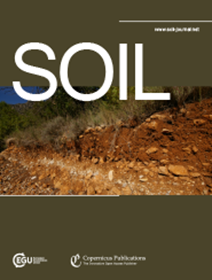Soil stoichiometric characteristics and influencing factors in karst forests under micro-topography and microhabitat scales
IF 4.3
2区 农林科学
Q1 SOIL SCIENCE
引用次数: 0
Abstract
Abstract. To quantitatively evaluate the stoichiometric characteristics of karst forest soils and their response mechanisms to complex microenvironments, the study systematically investigated soil stoichiometric traits and influencing factors across micro-topography and microhabitat scales in the Maolan karst forest. Key findings include: (1) Soil nutrients (organic carbon, total nitrogen, hydrolyzable nitrogen, available phosphorus, available potassium, total calcium, exchangeable calcium, and exchangeable magnesium) exhibited strong variability with significant spatial heterogeneity; (2) Microhabitat factors significantly influenced nutrient accumulation, though different elements showed distinct response patterns to microhabitat variations; (3) Micro-topographic parameters (slope gradient, aspect, and position) exerted indirect effects through gravity, light exposure, and erosion, driving the formation of gradient patterns in soil stoichiometry; (4) Differential response mechanisms of nutrients to abiotic factors, combined with the differential nutrient regulation and absorption strategies of various plant life forms, collectively shaped the complex stoichiometric characteristics. Synergistic interactions were observed among microhabitat-micro-topography-plant life form factors, with geomorphological abiotic factors playing predominant roles at this scale. Although biotic factors like plant life forms showed relatively weaker direct influences, their regulatory effects were closely interrelated with microhabitat-topographic factors. This multi-dimensional feedback mechanism between biotic and abiotic factors reflects the complexity of nutrient cycling in karst ecosystems.微地形和微生境尺度下喀斯特森林土壤化学计量特征及其影响因素
摘要。为了定量评价喀斯特森林土壤的化学计量特征及其对复杂微环境的响应机制,本研究系统地研究了毛兰喀斯特森林不同微地形和微生境尺度下土壤化学计量特征及其影响因素。主要发现包括:(1)土壤养分(有机碳、全氮、水解氮、速效磷、速效钾、全钙、交换性钙和交换性镁)表现出较强的变异性,且空间异质性显著;(2)微生境因子对养分积累有显著影响,但不同因子对微生境变化的响应模式不同;(3)微地形参数(坡度、坡向和位置)通过重力、光照和侵蚀等间接影响,驱动土壤化学计量梯度格局的形成;(4)营养物质对非生物因子的不同响应机制,加上各种植物生命形式的不同营养调节和吸收策略,共同形成了复杂的化学计量特征。微生境-微地形-植物生命形态因子之间存在协同作用,其中地貌非生物因子在微生境-微地形-植物生命形态因子中起主导作用。虽然植物生命形态等生物因子的直接影响相对较弱,但其调控作用与微生境地形因子密切相关。这种生物因子与非生物因子之间的多维反馈机制反映了喀斯特生态系统养分循环的复杂性。
本文章由计算机程序翻译,如有差异,请以英文原文为准。
求助全文
约1分钟内获得全文
求助全文
来源期刊

Soil
Agricultural and Biological Sciences-Soil Science
CiteScore
10.80
自引率
2.90%
发文量
44
审稿时长
30 weeks
期刊介绍:
SOIL is an international scientific journal dedicated to the publication and discussion of high-quality research in the field of soil system sciences.
SOIL is at the interface between the atmosphere, lithosphere, hydrosphere, and biosphere. SOIL publishes scientific research that contributes to understanding the soil system and its interaction with humans and the entire Earth system. The scope of the journal includes all topics that fall within the study of soil science as a discipline, with an emphasis on studies that integrate soil science with other sciences (hydrology, agronomy, socio-economics, health sciences, atmospheric sciences, etc.).
 求助内容:
求助内容: 应助结果提醒方式:
应助结果提醒方式:


